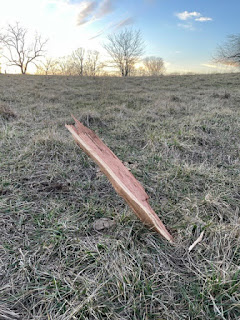 |
Our friend Judy Freeman told us about a lightning strike that destroyed a large red oak on the land she and her husband Steve own near Seymour. I contacted our new friend Dr. James Guldin* (a forest ecologist) and we drove out to see it. It was even more impressive than Judy had described. Before going further, review Jim's report on the site at this link.
It was roughly estimated to be 34 inches in diameter. Any estimation would make it well over 120 years old as confirmed by a tree ring count. Standing by the cemetery and the site of historic New Grove School, since then rebuilt, I can only imagine all the stories it could tell.
The tree literally exploded, spreading debris in all directions, covering approximately 8 acres. The section of the base of the trunk above was blown 70 feet from the base. You can see the charred area in the root junction.
 |
| Click to enlarge |
The other most impressive debris was this piece impaled 16" into the ground, 345 feet from the tree site! The angle gives some idea of its direction and altitude. The dark area was underground.
 |
| Judy and Jim |
This led me into a deep dive into lightning effects on a tree, and the results were truly shocking! (Sorry) First take a look at my video compilation of some strikes available on the web.
A lightning strike can carry 100 million volts and reach 5 miles long. It can produce instantaneous temperatures in excess of 50,000 degrees Fahrenheit. The science behind the various types of lightning and its effects is complex and beyond the limits of this blog (and its blogger). This Wikipedia link summarizes a lot of the lightning science
The effect lightning has on a tree has a lot to do with the conditions. If the bark is wet from rain, the strike may travel over the bark, not producing visible damage. In the first example in the video above the current passed down through the xylem and phloem, the vascular system under the bark. Since the sap is a poor conductor, it rapidly boils, producing the explosion of bark. I suspect that in Judy's case, the tree had moisture in the trunk. This would allow the instantly boiling liquids to expand dramatically, exploding the tree.
My parents told me 70+ years ago to never stand under or around a tree in a thunderstorm but apparently this isn't common knowledge. Lightning spreading through the soil around the tree base can pass through the a person's legs, up one and down the other causing collapse or worse. If you are preparing to be struck by lightning, hold your legs together Who knew! This dramatic video demonstrates what happens if you violate these rules.
Finally, if you haven't seen enough, here is video of dramatic strikes captured by a lightning aficionado. Lightning struck a tree on the ridge above Bull Creek last fall which you can see here.
________________________________________________________________*Dr. James Guldin is retired as Research Forest Ecologist and Center Director with the Southern Research Station of the US Forest Service. He had a 38-year career in Arkansas, first in academia with the Monticello Forestry School at the University of Arkansas (10 years) and then with US Forest Service. Jim now lives in Springfield, and is becoming active in the forestry and conservation communities in SW Missouri.
Thanks to Judy Freeman for sharing this amazing story with us.


